
Vol. XIV, No. 7, August 2014
- Editor's corner
- Eating out has become an adventure
- Society undergoing pernicious shift in socialization culture
- The top 10 ways restaurants piss people off
- More proof that High Fidelity wins
- Helio Center entertainment-restaurant center progress
- Where and how we spend our leisure time is sure to change
- Are families with children getting wealthier?
Society undergoing pernicious shift in socialization culture
[Pernicious: causing great harm or damage often in a way that is not easily seen or noticed]
We humans are hardwired for socialization. Being social animals, living together in families and tribes, is what enabled us to survive and prosper over our 200,000-year history. The need to socialize is built into our DNA. Social interactivity is a basic need, a fundamental part of our humanity.
In fact, psychologist Susan Pinker, in her forthcoming book, The Village Effect, argues that humans need face-to-face contact, just as much as they need air and water. She says that quality face-to-face contact is essential for a social species. The research she cites shows it is crucial for learning, happiness, resilience, health and longevity.
Up until 1876 with the invention of the telephone, our socialization was totally dependent on co-location, we had to be physically in the same location. Although the telephone allowed us to communicate across distances, we were still anchored to the locations where the telephone was located. And over history, the telephone had little impact on our other co-location dependent socialization. In fact, in many cases, it facilitated our ability to meet-up.
The Triple Revolution
Then along came the Triple Revolution - the free public Internet in 1993, social media in 2002, and constant mobile connectivity with the smartphone in 2007. Think about it; the smartphone is only seven years old and now we take directions from a machine as well as ask it for information and advice.
In an exceedingly short time, the Triple Revolution has brought about a rapid disruptive and transformative impact on just about every aspect of our lives, culture, society and business. The changes in just a few short years and where they are rapidly heading are as significant in transforming how we live, work and play as the changes that occurred over the 100-year plus Industrial Revolution.
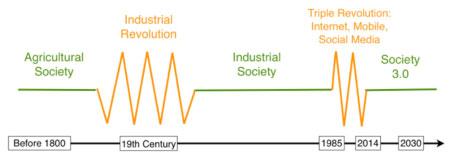
Changing Socialization Culture
With mobile devices and social media, email, texting, Skype and other communication apps, our socialization culture is undergoing major changes, and as Pinker points out in her book, not necessarily for the good. We are no longer dependent on location or time to socialize in the digital world. We no longer have to take the time or effort to physically meet-up face-to-face to socialize. We can do it anywhere at anytime. The geography and time of socialization is now limitless. And since such digital socialization can so conveniently satisfy our hard-wired desire to socialize, it is replacing our socialization in the physical world.
We have some solid evidence of this substitution of digital socialization in lieu of real world face-to-face socialization. Since 2003, the American Time Use Survey has documented the frequency, with whom and the time duration of 100's of American's daily activities. Among those activities are:
- Attending or hosting social events
- Socializing in person with others
The socializing in person with others is a pure socialization category. It does not including the socialization that takes place while dining or attending the arts, entertainment or sports.
The chart below shows how the number of people on a typical day who engage in either activity has decreased. there is a definite long-term trend of people socializing less and less in the real world.
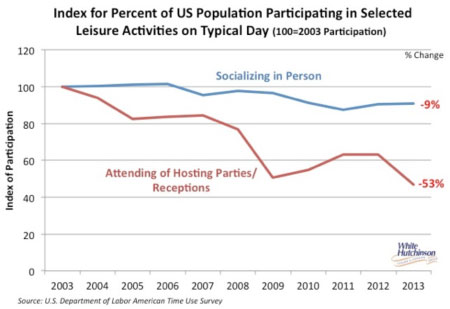
However, this does not prove a causal relationship that people spending more time socializing in the digital world are decreasing their real world socialization. We do have evidence of that cause and affect from a research paper by Scott Wallsten from the Technology Policy Institute that in fact, online leisure activities are displacing time spent face-to-face.
Crowding Out of Offline Leisure
Scott Wallsten reported his new research in an October 2013 working paper that is apply titled What Are We Not Doing When We're Online. Wallsten analyzed data from the 2003-2011 American Time Use Survey (ATUS). The ATUS shows that the total amount of time we spend on leisure has remained relatively constant between 2003-2011, at about five hours a day with only a few minutes variation from year to year.
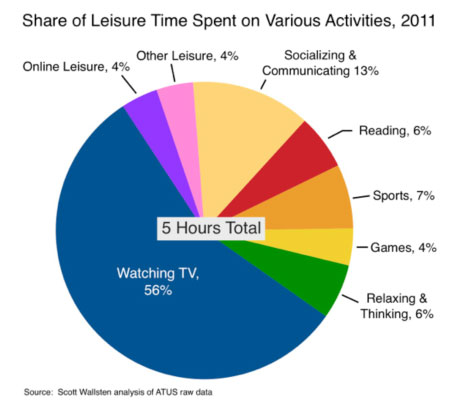
However, although the total amount of leisure time has remained constant, the ATUS data shows that the amount of time spent online and the share of the population engaged in online activities has been steadily increasing. It's a zero sum game - when time on online activities increases, there is a crowding out, a decrease of time spend on other leisure activities, as well as other type activities.
Wallsten measured the offline (real world) activities that are crowded out by our online social and leisure activities throughout the day. His analysis of online leisure included social media, browsing and instant messaging. His results show a crowding out effect of online leisure on offline leisure. He found that for every additional hour the average American spends with online leisure, they spend roughly 17 less minutes doing some other type of leisure like watching TV, going out for entertainment and socializing in more traditional ways.
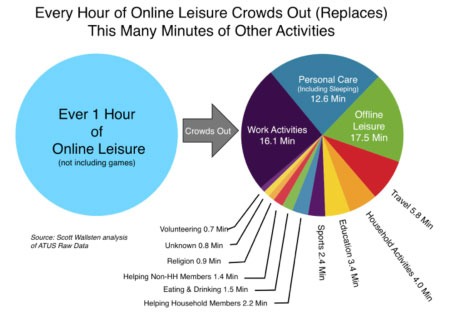
Wallsten looked at those people who spend online leisure time in 2011, and they averaged 100 minutes per day, one-third of their total leisure time. What that means is those 100 minutes of online leisure crowded out, displaced, one-half hour (29 minutes) of time that would have otherwise been spent on real world leisure activities.
Wallsten also said, “My results also suggest that other offline leisure activities that involve interacting with other people are crowded out by online leisure: attending parties and attending cultural events and going to museums [and entertainment venues] are all negatively correlated with online leisure. In short, these results based on ATUS data suggest that a cost of online activity is less time spent with other people.”
Wallsten's research was limited to time using the internet or time spent with online leisure doing things like spending time on social networks, browsing for non-work purposes and instant messaging, etc. It did not examine the crowdout impact of playing games and watching video online or from email, even though they can take up a lot of leisure time. There can be little doubt that the online time spent in those additional online leisure activities is also crowding out offline social activities, both person-to-person as well as while engaged in other leisure activities.
Half of Waking Hours with Media
The Communications Market Report just released this month by Ofcom, the communications regulator in the UK, contained a graph showing just how pervasive digital media has become in the lives of Westerners. The graph shows that British adults spend more than half their waking hours, 8 hours - 41 minutes, engaged in some kind of media, whether it is watching television, listening to the radio, on the internet or sending text messages and email. Adults in the US are not that different. And remember, this report is for adults. The Digital Generation, especially school age children, are sure to spend even more time each day engaged in media.
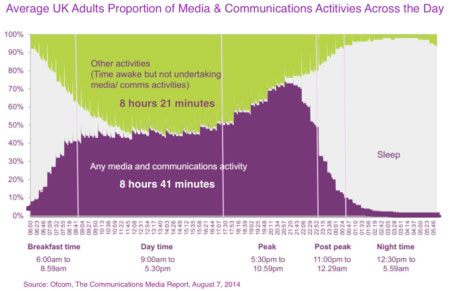
Tube Amplification
Television viewing consumes the largest share of our leisure time and is the number one competitor to people spending their leisure time away from home. In 2013, television viewing consumed an average of 2 hours and 46 minutes a day, more than half (55%) of our average 5.03 hours of leisure time each day. And TV viewing time is on the increase, up 8% since 2003, whereas time spent away-from-home at entertainment and cultural venues is on the decrease.
In the recent issue of Wired Magazine, Mat Honan wrote a very noteworthy and what should be frightening article for anyone in the location-based entertainment industry called “Tube Amplifier.” Here's an except from his article:
“The Internet has gotten better and better at letting us talk to one another... I can share something - on Twitter or Facebook or Instagram - about what I'm currently experiencing and immediately hear from others experiencing the same thing.
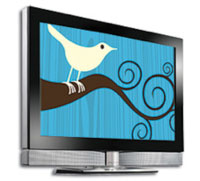
“This instant Internet, ubiquitous and pushed to our smartphones, lets us experience events not only as they happen but together - even when we are physically apart. It's not watching something at the same time as someone else; it's watching it with them. We're not just broadcasting anymore; we're conversation-casting.
“Television has talked to us for decades, but it never listened. While we all watched events like the moon landing at the same time, we did so in pockets of isolation. This is why the so-called second screen has triumphed over the first. It's why “second screen” is such a colossal misnomer; the phone is the first screen - always with us and always on. And it has made our big screens more vital. By combining the two, we connected ourselves.
“Thanks to this, live TV has never been better. The ability to comment immediately and have anyone respond has given live television a power-up; it has provided motivation to tune in to things we might otherwise skip or TiVo. Because a show isn't just something to watch anymore - it's a way to connect...”
Nielsen reports that in the 4th quarter of 2013 among Americans age 13 and older who owned a smartphone or tablet, 29% of smartphone owners and 23% of tablet owners were emailing, texting or otherwise having digital communications about TV programs with their friends located elsewhere. Nielsen also found that 15% of viewers reported they enjoyed watching television more when social media is involved.
This new internet-enabled social dynamic to watching television is the tube amplifier, or should we say flat screen amplifier, one part of a phenomenon called Social TV - simultaneously using social media while watching TV. Digital devices have turned the activity that consumes the majority of our leisure time, TV viewing, into an interactive, non-co-location dependent social experience, increasing the attractiveness of just staying home in front of the television to be entertained and socialize at the same time.
(Note, Randy White, our CEO, first reported about this social TV phenomena in May in two of his blogs. His blog is definitely worth following.)
Flight from Conversation
Sherry Turkle, author of Alone Together: Why We Expect More From Technology and Less From Each Other, has spent 15 years researching the relationship between people and mobile technologies and constant connectivity. She has identified a trend she calls flight from conversation brought about by texting and social media. Turkle says we, and especially children and younger adults, are developing conversation-phobia. What is happening is that people prefer to text and post on social media rather than talk on the phone or have face-to-face conversations.
Turkle believes that we are turning to this digitally-enabled form of communication “because technology appeals to us most where we are most vulnerable. And we are vulnerable. We're lonely, but we're afraid of intimacy. And so from social networks to social robots, we're designing technologies that will give us the illusion of companionship without the demands of friendship. We turn to technology to help us feel connected in ways we can comfortably control.” So, in effect, people are turning away from face-to-face socialization in the real world to safer, more comfortable digital communication.

The Appeal of Digital Socialization
As Turkle found, the digital socialization that the Triple Revolution has given birth to has a very strong and constant appeal. Although research tells us that social engagement in the digital world is not as satisfying as in the real world and that most people actually prefer in-person socialization (at least that's what they say in surveys), constant connectivity's on-all-the-time convenience and low cost (both money and effort) and its comfort still makes digital socialization a powerful draw. It's just too easy and convenient to socialize and try to satisfy our hardwired DNA in the digital world. We can just cocoon at home as well as socialize on the go with our constant connectivity options. Meeting up in person just takes so much more effort and time and as Turkle believes, isn't perceived as safe a means of communication. So we settle for second best.
We've given ourselves something so gratifying that we can forget other ways to communicate. What starts out being better than nothing becomes better than anything.
Sherry Turkle
Jenna Wortham, in her recent The New York Times Bits blog I had a nice time with you tonight. On the app, pointed out, “We are in constant and continuous communication with our friends, co-workers and family over the course of a day. These interactions can help us feel physically close, even if they happen through the screen.” Yes, close, but not face-to-face.
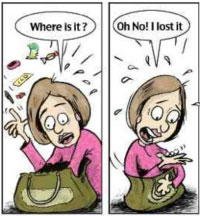
Nomophobia
The pull of constant connectivity has even resulted in the study of the modern maladies of what is called connectivity addiction and nomophobia (no-mobile-phone phobia) that has afflicted many people. Nomophobia was first coined in a 2010 study by the UK Post Office that found that 53% of mobile phone users tend to be anxious when they “lose their mobile phone, run out of battery or credit, or have no network coverage.”
Nomophobia is the pathological fear of remaining out of touch with technology.
One study found that 57% of women would rather give up sex than their smartphone for a week. There's now even a website endnomophobia.com to help cure nomophobes. There's also a movement underway to have psychiatry's diagnostic manual be updated to include this pathological fear.
It's Not About the Entertainment
When adults were asked for their main motivations in deciding how to spend their leisure time in a recent Impacts Research & Development survey, 70% answered to visit friends and family (the highest percentage of all answers). The primary reason most people visit entertainment and leisure venues is to socialize with friends and family. That is the most important benefit they get from the visit. It's not the entertainment, nor the food and beverage. The entertainment, and the food and beverage are only the stage that facilitates the socialization.
The Challenge of the Siren Call
However, the siren call of the digital world and its disruption to our face-to-face social lives is the 21st Century challenge for located-based leisure venues. Data from the ATUS survey clearly shows that every year less and less people are leaving their homes to visit entertainment, arts and sports venues. In 2013, more than one-quarter less (-27%) people participated at those venues than ten years earlier.
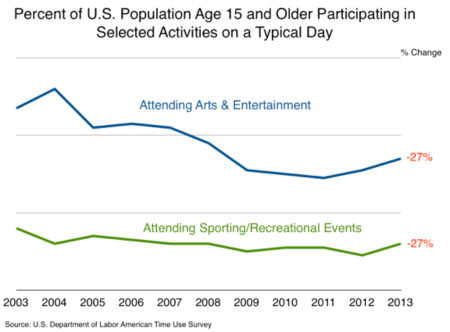
This long-term trend started much earlier then the Great Recession, obviously brought about by the growing adoption of and advances in digital technology. Why take all the effort and time to visit some venue with family or friends when you can just sit home and socialize with your family there or via technology with friends? Plus, we have so many digital entertainment options, there is no need to go out to be entertained. In fact, Mintel, a market research and insight company, reports that 57% of Millennials say they prefer to spend their downtime in front of an electronic device and are more likely to spend their leisure time alone.
We are in the mist of a profound transformative and disruptive shift from real world to digital entertainment and it's happening far faster than most people in the location-based entertainment industry realize.
Randy White, CEO,
White Hutchinson Leisure & Learning Group
Less Stuff
One other trend we are seeing that can work in favor of location-based entertainment is that consumers are turning more and more away from buying stuff to spending on experiences, which of course includes spending money on out-of-home experiences. However, experiential purchases also include buying experiential material goods that can deliver experiences, such as large screen ultra high definition televisions, mobile devices, apps, media subscription services and other forms of technology to enjoy at home with mobile devices. So again digital experiences rear their competitive siren call.
The Challenge
To compete with the Triple Revolution and the growing digital disruption it has brought to the culture of socialization, to attract people to bricks-and-mortar entertainment venues to engage in real world face-to-face socialization, now requires a much more compelling, attractive, appealing, premium, High Fidelity offering than in the past. That offering has to be about much more than the entertainment. The physical facility and its ambiance, the hospitality, the food and beverage all have to come together with the entertainment in a social experience that is a highly attractive alternative to the digital world. And the bar to achieve that challenge is sure to continually go up in the future.
Vol. XIV, No. 7, August 2014
- Editor's corner
- Eating out has become an adventure
- Society undergoing pernicious shift in socialization culture
- The top 10 ways restaurants piss people off
- More proof that High Fidelity wins
- Helio Center entertainment-restaurant center progress
- Where and how we spend our leisure time is sure to change
- Are families with children getting wealthier?


